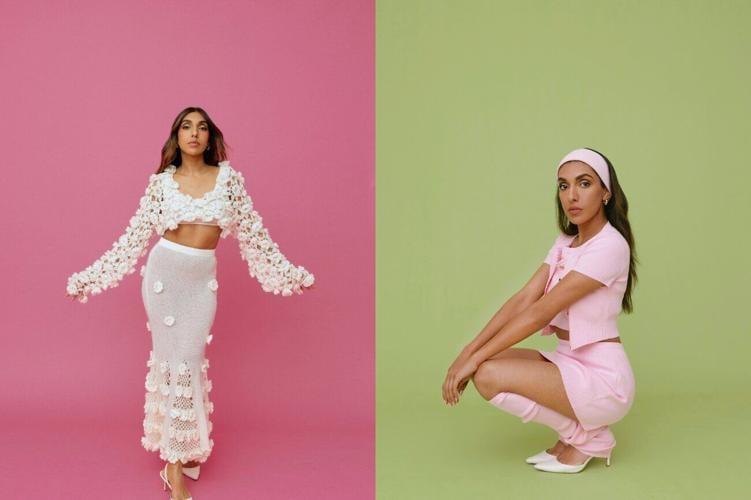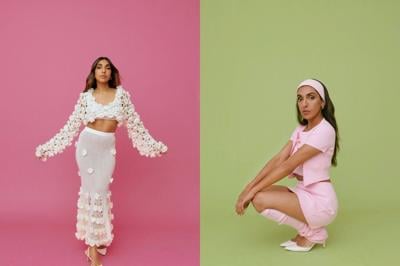Rupi Kaur should be used to this by now.
The poet recently attended Adeleâs residency in Las Vegas. When asked in 2022 which book sheâd take to a desert island, the singer chose Kaurâs 2017 collection, âThe Sun and Her Flowers.â After learning Kaur would be in the audience, Adele sent over a signed tour book with a note saying that Kaurâs work had helped her get through her divorce.
âI was like, oh my God, what the hell?â Kaur told the Star in a recent interview, her expression a callback to the shock-tinged pride sheâd felt in the moment.
The exchange was a Hollywoodized version of a story the former Brampton resident (now based in Los Angeles) has heard countless times in the 10 years since she published her first poetry collection, âMilk and Honey.â Kaurâs words have saved peopleâs lives. Been their compass through loss. Buoyed them during depression. Empowered them into self-actualization. These are the stories her fans tell her every day.
The modern hotel room from which Kaur was speaking signalled yet another notch in her belt of accomplishments: sheâs in Cincinnati for the Forbes 30 Under 30 Summit. At 31, she’s too old to be on the 2024 list. (Sheâd been there, done that in 2018.) Instead, she was invited to perform a poem and sign books as part of the summitâs mission to gather the sharpest minds in business, entertainment and sports.
Kaur is calling this the âpre-tour.â Next week, sheâll head out on a 15-stop book-signing trek across the U.S. and the U.K. to celebrate the 10th anniversary collectorâs edition of âMilk and Honey.â

The new, 10th anniversary edition of “Milk and Honey” features annotations and a new chapter.
Andrews McMeelIt’s a lifestyle more fitting for a rock star than a poet, but therein lies the singularity of Rupi Kaurâs ascent. Her digestible stanzas on heartbreak, self-love, family and immigration have resonated widely enough for her to claim the rare hyphenate of âŒőŽÇ±đłÙ-łŠ±đ±ô±đČú°ùŸ±łÙČâ.â Sheâs recognized in the street. Her work is tattooed onto peopleâs bodies. She has an Amazon Prime special.
âThis whole life is crazy,â she said. âIt still doesnât feel real.â
Birth of a poet
Kaur self-published âMilk and Honeyâ while studying at the University of Waterloo in 2014. She penned her poems between classes and parties, fielding warnings that success was a pipe dream.
âTwelve years ago, I remember my professor telling me, âYou know, youâre not going to get published,ââ she said. ââYouâre better off trying to submit to anthologies and journals, because if you go look at the poetry shelf, itâs a lot of old, dead white guys.ââ
This advice, though harsh, would have been practical for the time. Poetry was not being quote-tweeted and consumed by the masses. âPoetâ would have placed near the bottom of a list of sustainable career paths. Why should Kaur be the exception?
What this naysaying professor likely didnât know was that Kaur had already been building a small but loyal community of fans across social media platforms like Tumblr and Instagram, adapting her long-form performance poetry into bite-sized pieces of content primed for sharing and scrolling. She eventually configured what would become her âInstapoetryâ signature: poem on white background, Times New Roman font, left-justified, with a doodle at the bottom right.

Rupi Kaur has posted her poetry with illustrations on Instagram.
Instagram @rupikaur_Kaurâs sister shot the promotional images for âMilk and Honeyâ on her iPhone 5. The poet self-published the book using Amazonâs CreateSpace service and sold copies at local events. A few months after its release, Andrews McMeel Publishing got wind of the 21-year-old independently selling 18,000 copies of a poetry collection and signed her to a deal.
Those 18,000 turned into more than six million copies worldwide, outselling ÎÚŃ»Ž«Ăœrâs âThe Odysseyâ by a factor of 10 to one. The book sat on the New York Times bestseller list for nearly four years and has been translated into more than 40 languages.

The original “Milk and Honey” has sold more than six million copies and has been translated into over 40 languages.
Andrews McMeelâA lot of my readers will say that âMilk and Honeyâ was a sort of gateway to them realizing that poetry was something they could relate to,â she said.
While Kaur has been an entry point for many, poetry had long been a fixture in her own life. Growing up in a Sikh household, having immigrated with her family to Canada from Punjab as a young girl, she makes a distinction between Western and Eastern approaches to the literary form. Her experience with the former often involved classroom assignments, rubrics, and time-crunched analyses. The latter was seamlessly woven into family dinner table conversations from the time she was a child.
âMy grandparents couldnât read or write, but they all had poetry,â she explained. âIt was something that they shared intergenerationally within the village they grew up in. Poetry is not only a part of the mainstream culture in many parts of the East, but it is also deeply accessible, no matter your class or your education. Itâs like the language and the music of the people, and thatâs how I view it. And because I am between these two worlds, what I try to do is bring that welcoming community vibe and that accessibility to English.â
Simply put
In some literary circles, âaccessibilityâ is a dirty word. Thereâs an idea that poetry should be challenging rather than obvious; that understanding is earned, not universally granted; that poems should be sat with and held, not scrolled through. While some critics have praised Kaur and her âInstapoetâ peers for reviving mass interest in poetry, her simple, to-the-point style has also triggered backlash.
Over the years, sheâs been the subject of long-form takedowns with headlines like âThe Problem with Rupi Kaurâs Poetryâ and âWhy Do We Love to Hate Insta-Poet Rupi Kaur?â When The New Republic called her “the Writer of the Decadeâ in 2019, the internet transformed into a game of think-piece whack-a-mole.
Whether one considers this pushback a symptom of the industryâs gatekeeping or preservation, Kaur seems entirely unbothered. Accessibility, for her, is a compliment and a choice.
âI am very particular about the diction that I use,â she said. âI want my paper poetry to feel like a concentrated shot that you take, and it hits you hard and fast. You donât need to do much work trying to figure out what Iâm trying to say, because the work you need to do is the hard work of processing that challenge in your life or the trauma.â
In this way, Kaur sees her writing as âemotional work.â âMilk and Honeyâ is divided into four sections: âthe hurting,â âthe loving,â âthe breaking,â and âthe healing.â (In the new edition, Kaur adds a fifth chapter: âthe remembering.â) Within each section, her own traumas and growth, and the universal experiences of womanhood, are chiselled down to their studs.
âthe rape will
tear you
in half
but it
will not
end youâ
Also in the new edition are Kaurâs handwritten reflections on her past work. The red scrawl accompanying this piece declares: âTo any survivors who may be reading this, I know your pain and hold it next to mine.â
âThatâs why I wrote,â Kaur said. âI didnât have access to therapy and other mental health resources. And as a survivor of sexual assault, not having my parents to lean on, poetry was the tool where I sat and self-therapized.â
For Kaurâs fans, who are predominantly women, her work functions as their own hand-held therapy. Accessibility begets relatability. Relatability begets healing. In 2022, Kaur even released a guide titled âHealing Through Words,â offering writing prompts to help readers process their own trauma and heartache.

âHealing Through Words,â released in 2022, offers writing prompts to help readers process their own trauma and heartache.
Simon & SchusterMuch has changed in the 10 years since the publication of âMilk and Honey.â One poetry collection has become three. A side hustle has become an enterprise. Frustrations with her parents have transformed into empathy. Past toxic relationships are now the punchline to her growth. Impostor syndrome has (mostly) evolved into confidence.
But one of the biggest shifts has occurred within the publishing world from which Kaur was first shunned. When asked which metric of success she is most proud of, the poet pulled out her phone to avoid misquoting an article recently sent to her by a friend.
âFew books this century have changed the publishing landscape as much as Rupi Kaurâs âMilk and Honey,ââ she read carefully. âIn commercial terms, Kaurâs impact on poetry bears comparison with J.K. Rowlingâs impact on childrenâs writing.â
Thereâs no mention of the fact that this excerpt is taken from a Telegraph article headlined, âRupi Kaur: The superstar poet that critics love to hate.â Because, maybe, who cares? Kaur has witnessed her own impact first-hand.
Under her influence
Last year, while Kaur performed in Sao Paulo, a woman shouted from the crowd. (This isnât unusual, as the poet encourages audience members to share their experiences in the way she divulges her own.)
âCan I share a story?â the woman asked.
Kaur, somewhat reluctantly, handed her the mic.
The fan explained that after âMilk and Honeyâ was translated into Portuguese and became a bestseller in her country, Kaurâs Brazilian publisher was looking for women writing about similar themes of love, loss and empowerment. They found her, published her work, and she became one of Brazilâs bestselling poets. Her name is Ryane LeĂŁo.
âShe was like, âI was able to do that because you did what you did,ââ Kaur recalled with smile. âShe lifted up her book, and then all these other women in the audience were like, âMe too. Me too. Me too.ââ
When Kaur came home from her world tour, she could fill shelves with the books her fans had given her. Ones they had written. Some were released through a publisher, others independently, just as Kaur had done.
âThatâs the thing Iâm most proud of,â she said, âis if this book has given permission to anyone to just write and be loud and be fearless.â
Itâs a notable legacy to have established in your 20s, and itâs one the writer intends to keep building in the decades to come.
âI have my entire life ahead of me,â she said. âI want to write my best work at 80, because writing and performing is something Iâm going to do for the rest of my life, whether I have an audience or not. Iâm excited to use this book as a sort of bookend to a certain era where I was really just learning about my voice and trying to find my confidence. Now Iâve really found that, and Iâm having fun with it.â



































To join the conversation set a first and last name in your user profile.
Sign in or register for free to join the Conversation